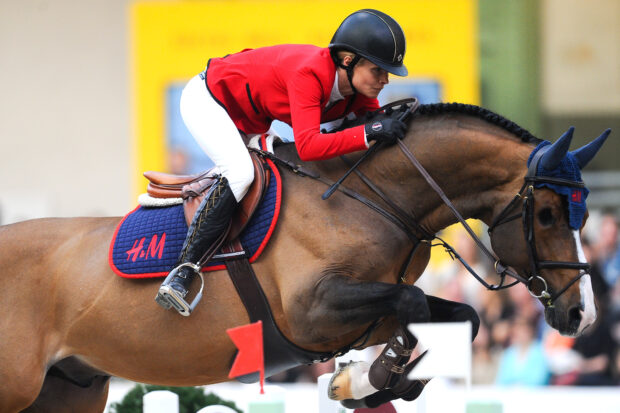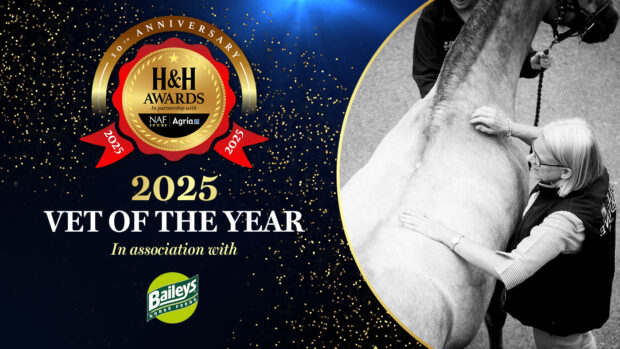A protocol for treating dry eye problems in humans has been successfully adapted for horses and it is hoped more animals could benefit.
Helen Newlands’ 26-year-old gelding Ryan has struggled with a chronic eye issue for some time. Ryan, who was otherwise healthy and bought as a six-year-old for low-level eventing, first presented with a weeping and closed eye, and was found to have ulceration on the surface.
Helen told H&H Ryan started treatment under the Dick Vet Equine Hospital in Edinburgh, and for periods of time his eye would improve, but the ulcers continued to return. After seeing an equine ophthalmologist Ryan was diagnosed with immune mediated keratitis (IMK), and following a course of treatment he went into remission, but again, the ulcers came back.
“In 2016 we went through a really difficult time,” Helen said. “It would clear up, ulcer, clear up, ulcer.

Ryan’s ulcerated eye
“We saw the ophthalmologist again and it was suggested we try debriding the cornea, to almost reset it. It seemed to help, but then three months later he got another ulcer.”
Helen said there were conversations about removing Ryan’s eye, but in early 2021 vet Susie Armstrong sat down with human ophthalmologist Fraser Peck to review Ryan’s case. Focus was placed on Ryan’s meibomian glands, which produce lipids that form the surface lipid layer of the tear film. When the tear film becomes defective, the surface of the eye can become dry and the result can be ulceration.
A human treatment protocol for dry eyes was adapted for Ryan and he started the new regime in March 2021. This involved daily hot compresses, and the use of a lubricant, serum and topical antibiotic.
“We started getting excited after six months. Ryan wasn’t getting anything recurring, and we seemed to be getting somewhere,” said Helen.
“He remained under review and would go into the hospital to check his meibomian glands every so often. They also performed tear film tests and could see that his tear film was improving, which meant his dry eye was improving”.
Ryan will remain on the regime indefinitely, and although he has had the occasional ulcer since, these have cleared up quickly. Helen said his quality of life has improved and he continues to enjoy hacking in his retirement.
“He was out 24/7 during the summer, and I can’t remember the last time we were able to do that because we used to be too nervous to leave him out in case he came in with an ulcer,” she said.
“I’ve had the same yard owner, Pammy Stevens, for 20 years and without her support I wouldn’t have gotten through it all. It was emotionally draining, it was upsetting, and financially it was difficult. His eye was only insured for one year so I’ve spent thousands over the years, but this new regime is inexpensive.”
Helen said Susie has been “so committed” to helping Ryan, and this year she nominated her in the Petplan Veterinary Awards.
“Susie first came to see Ryan in 2016 as a locum, and she’s absolutely changed everything for us,” she said.
Susie, who was a lecturer in equine practice at the University of Edinburgh and is now a senior lecturer in veterinary clinical research at the University of Surrey, published Ryan’s case in VetRecord CaseReports last year. She has presented lectures on the protocol internationally, which have been met by veterinary experts positively.
“The protocol is not groundbreaking in itself, but what we’ve done is adapted the human protocol for use in animals. We have always put eye issues like these to mechanical problems for example with their eyelid, or there has been an underlying infectious component that continues to cause these ulcers,” she said.
“We’re now working towards better objective tests to support clinics and practices who maybe don’t have all the tools they need to make these diagnoses. We’re starting to change the narrative to look at the tear film when looking at eyes, which we didn’t previously do.”
Susie added that removing a horse’s eye is generally the last option, and in Ryan’s case, “it never crossed the ethical line that he would be better without his eye”.
Susie said Ryan’s case has been a “success story”.
“It’s led to us thinking what else can we do,” she said. “The protocol is being rolled out in small animals and there are people around the globe implementing the protocol in other equine cases. We’re waiting to gather all the data and we plan to publish a case series.”
You might also be interested in:

‘I’ve really missed him’: young horse who lost eye makes winning competition return

4 common eye problems in horses and how to treat them
Stay on the look out for these common eye problems in horses

Subscribe to Horse & Hound magazine today – and enjoy unlimited website access all year round
Horse & Hound magazine, out every Thursday, is packed with all the latest news and reports, as well as interviews, specials, nostalgia, vet and training advice. Find how you can enjoy the magazine delivered to your door every week, plus options to upgrade your subscription to access our online service that brings you breaking news and reports as well as other benefits.




